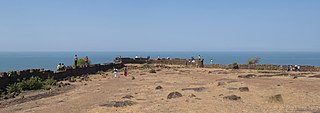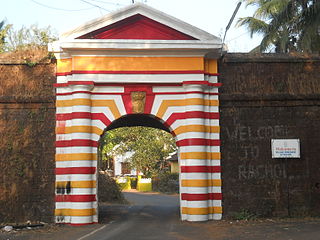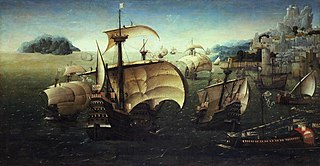
Panaji is the capital of the Indian state of Goa and the headquarters of North Goa district. Previously, it was the territorial capital of the former Portuguese India. It lies on the banks of the Mandovi river estuary in the Tiswadi sub-district (taluka). With a population of 114,759 in the metropolitan area, Panaji is Goa's largest urban agglomeration, ahead of Margao and Mormugao.

The Deccan Sultanates were five late-medieval Indian kingdoms—on the Deccan Plateau between the Krishna River and the Vindhya Range—that were ruled by Muslim dynasties: namely Ahmadnagar, Berar, Bidar, Bijapur, and Golconda. The sultanates had become independent during the break-up of the Bahmani Sultanate. The five sultanates owed their existence to the declaration of independence of Ahmadnagar in 1490, followed by Bijapur and Berar in the same year. Golconda became independent in 1518, and Bidar in 1528.

Krishnadevaraya was an emperor of the Vijayanagara Empire reigning from 1509 to 1529. He was the third monarch of the Tuluva dynasty, and is considered to be one of the greatest rulers in Indian history. He ruled the largest empire in India after the fall of the Islamic Delhi Sultanate. Presiding over the empire at its zenith, he is regarded as an icon by many Indians. Krishnadevaraya earned the titles Andhra Bhoja, Karnatakaratna Simhasanadeeshwara, Yavana Rajya Pratistapanacharya, Kannada Rajya Rama Ramana, Gaubrahmana Pratipalaka and Mooru Rayara Ganda. He became the dominant ruler of the peninsula by defeating the sultans of Bijapur, Golconda, the Bahmani Sultanate and the Gajapatis of Odisha, and was one of the most powerful Hindu rulers in India.

The Adil Shahi or Adilshahi, was a Shia, and later Sunni Muslim, dynasty founded by Yusuf Adil Shah, that ruled the Sultanate of Bijapur, centred on present-day Bijapur district, Karnataka in India, in the Western area of the Deccan region of Southern India from 1489 to 1686. Bijapur had been a province of the Bahmani Sultanate (1347–1518), and member of the Deccan Sultanates, before its political decline in the last quarter of the 15th century and eventual break-up in 1518. The Bijapur Sultanate was fully absorbed into the Mughal Empire on 12 September 1686, after its conquest by the Emperor Aurangzeb.

Abu Muhammad ʿAbdallah 'al-ʿAdil' was an Almohad Caliph, a former governor in al-Andalus who challenged and secured the murder of his predecessor, Abd al-Wahid I. His 1224 coup ushered in a period of instability that lasted well beyond his own death in 1227. He is often regarded as one of the most disastrous of Almohad caliphs. His coup divided the Almohads and set in motion the loss of al-Andalus and the eventual collapse of the Almohad state.

Yusuf Adil Shah (1450–1510), referred as Adil Khan or Hidalcão by the Portuguese, was the founder of the Adil Shahi dynasty that ruled the Sultanate of Bijapur for nearly two centuries. As the founder of the newly formed Bijapur dynasty, Yusuf Adil Shah is credited with developing the town of Bijapur and elevating it to significant status.
Genie in the House is a British sitcom broadcast on Nickelodeon about a widowed father (Philip) with two teenage daughters who find a golden lamp while exploring the loft of their new home. A rub of the lamp releases Adil, a trainee genie from Balamkadaar who has been confined to life in the lamp for a thousand years. Genie in the House ran for four series, from May 2006 to December 2010, with a total of 78 episodes. The series was aired in over 100 countries and in March 2012, Genie in the House aired on the Starz Kids & Family pay-TV network in the United States.
Sport Lisboa e Benfica, commonly known as Benfica, is a professional futsal team based in Lisbon, Portugal, that plays in the Liga Portuguesa de Futsal.

The Battle of Raichur was fought between the Vijayanagara Empire and the Sultanate of Bijapur in 1520 in the town of Raichur, India. It resulted in a decisive victory for Vijayanagara forces, and the Bijapur ruler was defeated and pushed across the river Krishna.

Chapora Fort, located in Bardez, Goa, rises high above the Chapora River. The site is the location of a fort built by Adil Shahi dynasty ruler Adil Shah and called Shahpoora, whose name was altered to Shapora (chapora) by Malvankar on the request of the Portuguese. It is now become a popular tourist spot and offers a view north across the Chapora river to Morjim

Adil Rami is a French former professional footballer who played as a centre-back.

The Portuguese conquest of Goa occurred when the governor Afonso de Albuquerque captured the city in 1510 from the Adil Shahis. Old Goa became the capital of the Portuguese India which included territories such as Fort Manuel of Cochin, Bom Bahia, Damaon & Chaul. It was not among the places Albuquerque was supposed to conquer. He did so after he was offered the support and guidance of Timoji and his troops.
The following lists events that happened during 1501 in India.
Events from the year 1555 in India.
Events from the year 1510 in India.

The Goa Legislative Assembly is the unicameral legislature of the state of Goa in India. The Assembly meets at the Goa State Legislative Assembly Complex in Porvorim, Bardez. The Eighth Goa Legislative Assembly consists of 40 members. The assembly is in charge of the budget, the Assembly appropriates money for social programs, agricultural development, infrastructure development, etc. It is also responsible for proposing and levying taxes.

The Rachol Fort is a historical Portuguese era fort located in the village of Rachol, Salcette concelho, in the state of Goa on the west coast of India.

The War of the League of the Indies was a military conflict in which a pan-Asian alliance formed primarily by the Sultanate of Bijapur, the Sultanate of Ahmadnagar, the Kingdom of Calicut, and the Sultanate of Aceh, referred to by the Portuguese historian António Pinto Pereira as the "league of kings of India", "the confederated kings", or simply "the league", attempted to decisively overturn Portuguese presence in the Indian Ocean through a combined assault on some of the main possessions of the Portuguese State of India: Malacca, Chaul, Chale fort, and the capital of the maritime empire in Asia, Goa.

Safa Mosque or Safa Shahouri Mosque is a mosque located at Ponda within Goa, India. It is a sixteenth century Islamic Monument. The mosque has a complex consisting of garden and fountains. The terracotta tile roof accommodates a rectangular prayer hall. It is an ASI protected Monument of National Importance in Goa.
The 2018 Braga Open was a professional tennis tournament played on clay courts. It was the 1st edition of the tournament which was part of the 2018 ATP Challenger Tour. It took place in Braga, Portugal between 7 and 13 May 2018.














